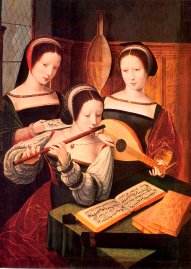|
Composers

Chopin

Mendelssohn
|
 Ternary forms
Forms consisting of three parts:
an opening section, including the main themes, part B develops those themes,
and a closing A (or a modified A') section. This form of a reprising A
section is a typical poetic form from ancient
times
Ternary forms
Forms consisting of three parts:
an opening section, including the main themes, part B develops those themes,
and a closing A (or a modified A') section. This form of a reprising A
section is a typical poetic form from ancient
times and 12th century minesienger
and 12th century minesienger songs and the opera song - the aria da capo
songs and the opera song - the aria da capo .
In the sonata
form .
In the sonata
form ,
in which symphonies ,
in which symphonies and sonatas are written, the minuet
and sonatas are written, the minuet movement is also written as a ternary form
(minuet-trio-minuet).
Ternary structures are also found
among 19th century piano
movement is also written as a ternary form
(minuet-trio-minuet).
Ternary structures are also found
among 19th century piano pieces, such as Mendelssohn's
pieces, such as Mendelssohn's "Songs Without Words"
and the nocturnes
"Songs Without Words"
and the nocturnes and waltzes
and waltzes of Chopin
of Chopin  ,
and in the slow movements of many Classical sonatas,
symphonies and
concertos ,
and in the slow movements of many Classical sonatas,
symphonies and
concertos . .

Examples of Ternary form
 Etude in Gbm, Op.10 No.5 'Black Key' by Chopin
Etude in Gbm, Op.10 No.5 'Black Key' by Chopin
|
 Sicilienne from 'Pelleas et Mélisande'
by Fauré
Sicilienne from 'Pelleas et Mélisande'
by Fauré
|
|
Xtend
 Listen
Listen
 Period
Period
 Scheme
Scheme
 Dictionary
Dictionary
 Internet
Internet
 Projects
Projects
 Finders
Finders
|